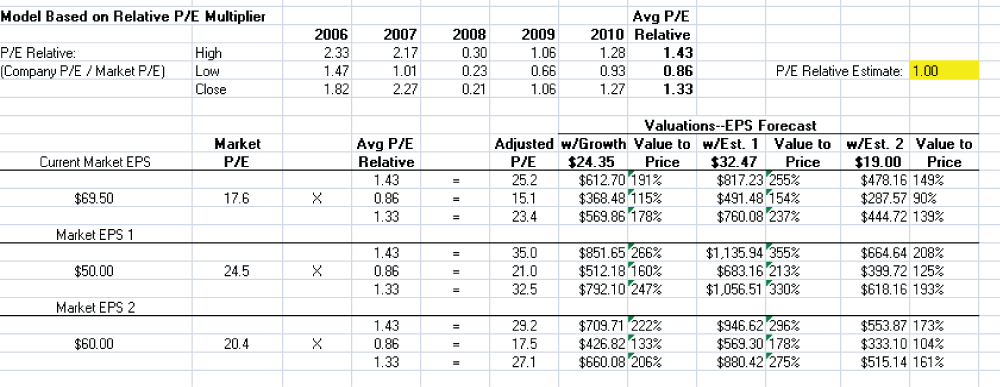How to Use the Earnings Multiple Valuation Method
Post on: 16 Март, 2015 No Comment

The formulas, tricks and trade secrets of Private Equity
How to Use the Earnings Multiple Valuation Method
Following on from my previous post regarding investee valuations, I want to give a brief explanation of (and make a few comments on) the earnings multiple valuation method. As discussed in other posts, this is the preferred valuation method for most situations. It represents what someone would pay if you tried to sell under normal conditions, which is arguably the most appropriate valuation method for private equity investments.
In the broad strokes, the earnings multiple valuation method involves applying an industry-based multiple to the earnings of a business to arrive at an implied enterprise value. From this enterprise value, subtracting net debt gives the equity value. In simple scenarios (involving only ordinary equity), a private equity firms relevant investment value is equal to their proportional stake in the investees equity.
The subjectivity of the earnings multiple valuation method comes in the following forms:
- Do you use last years actual earnings number? Do you use a forecast? If so, whose forecast do you use? And what earnings are we talking about: NPBT, NPAT, EBIT, EBITDA? What about the effect of non-recurring costs, contributions from discontinued business units, forecast acquisition synergies, etc?
- What is an appropriate multiple? Are transactions from six months ago reasonable comparisons? Should I only use transactions from the same industry as comparables? What about company size: should I only compare those of similar size? What if there havent been any transactions for 12 months (this is especially applicable now)? Should I use the mean, mode or median of comparable transactions?
There are a lot of questions there and not many answers; it really depends on how honest you want to be with yourself and the limited partners. Here are my suggestions:
- Earnings — You should use the earnings number that you expect at the time of reporting. For example, this may be the current years EBIT forecast adjusted for the latest actual earnings figures (that is, if you were below budget, adjust the forecast months accordingly). If the trend is towards using the previous years earnings, then you should follow suit.
- Multiple — In the current climate, you may need to look outside your industry for trends, but also make sure to look for similar sized transactions. Theres no perfect multiple to use, but theres certainly a range that will seem reasonable. Id say in the current environment that anything over 8-10x would be unreasonable. For mid-market deals, I wouldnt expect to see multiples over 6-7x, unless there is a strong case for exceptional growth. It may surprise you, but Im seeing some interesting deals go for 3x now.
Youll know in your own mind whether youre being fair with your earnings multiple valuation method analysis. Try not to cheat yourself because theres a real danger that it could come back to haunt you. Theres always the argument that if things really do get better, investors will be glad to see a significant uptick in your next report. If youre too optimistic now, disappointing them twice will hardly be fun. Also, investors wont be surprised with value losses now; theyre probably expecting them. So take this opportunity to take an honest look at your portfolio and move on to planning for the upturn (now theres some positive thinking).
Where market-based earnings multiples are used, the aim is to spot corporations that are similar each in terms of risk attributes and earnings growth prospects. several non-public equity corporations are additional highly leveraged than their quoted comparables, creating a comparison of earnings (after interest charges) less relevant. Using EBIT,changed for tax, as an approx earnings could be adjusting for variations within the operating capital structure of the businesses. during this context EBIT is adjusted by the expected tax cost, calculated at the marginal tax rate.
The earnings multiple valuation method is that the most well-liked valuation methodology for many things. It represents what somebody would pay if you tried to sell beneath traditional conditions, that is arguably the foremost acceptable valuation methodology for personal equity investments.
Valuation using the earnings multiple valuation method could be for determining the present price of a corporation by examining and comparing the monetary ratios of relevant peer teams, additionally usually described as comparable company analysis (or comps). the foremost widely used multiple is that the price-earnings ratio (P/E ratio or PER) of stocks in an exceedingly similar trade. Using the typical of multiple PERs improves reliability however it will still be necessary to correct the PER for current market conditions.
P/E multiples are well-liked partially attributable to their wide availability. the worth of a business ought to, however, be mirrored in multiples primarily based on enterprise price (EV/EBITDA, EV/EBIT, EV/NOPAT) of a corporation. These multiples reveal the rating of a business independently of its capital structure, and are the foremost commonly utilised in transactions on non-public corporations.
How to Use the Earnings Multiple Valuation Method
Read ALL of this and much more in the 200+ page eBook (see below)














